
What does the IPCC SREX report mean for India?
Mihir Bhatt was a coordinating lead author of Chapter 9 of Intergovernmental Panel on Climate Change (IPCC) Special Report on “Managing the Risks of Extreme Events and Disasters to Advance Climate Change Adaptation (SREX) and leads All India Disaster Mitigation Institute that has worked in 37 cities and 45 districts in India since 1995. Here Mirhir talks about the what the findings of the report mean for India.
The value of any report, once it is published, is its use: who uses it, how, where, and why. The huge Intergovernmental Panel on Climate Change (IPCC) Special Report on “Managing the Risks of Extreme Events and Disasters to Advance Climate Change Adaptation (SREX)” is no exception. I spoke with government authorities, the UN, international and domestic non governmental organisations, media and researchers about the implications of SREX at the well-attended South Asia Regional Outreach Event for the SREX Report in Delhi. This note outlines three major themes from these discussions, on how SREX messages could influence policy and practice in India.
First, the findings and messages of the SREX report must filter down to state level in India: many of the report’s messages are clear on actions that can be taken now. It is the states who manage disaster risks as well as make adaptation plans in India. The All India Disaster Mitigation Institute’s (AIDMI) ongoing disaster risk reduction work in 10 states of India indicates that the state authorities and NGOs are closer to risk and risk reduction measures than national government. The states set objectives and mobilise teams. Therefore, without raising awareness of SREX findings and recommendations at state level, direct concrete actions on the ground may be lacking.
For example, Concern Worldwide and Sabuj Sangh’s work to build the resilience of communities living in the Sunderbans delta can draw on SREX findings, to help determine the location of harbours, inform construction of embankments, and to foster sustainable forestry. To give another example, the SREX findings can inform the plans of ECHO and its partners Plan and Save the Children in Odisha. Here, organisations are delivering cash transfers to flood-affected communities; after the 2011 floods, this programme has a new focus on agricultural development for small farmers and protection of coastal ecosystems. The SREX findings cannot be ignored in the hill area development plan of Ladakh, being developed by Ladakh Hill Areas Autonomous Council and a multitude of similar plans, projects and programmes. The Government of India must find ways, then, to disseminate the SREX report’s important messages to inform the states, and to encourage them to turn the recommendations into context-specific actions.
Second, the messages of the SREX report apply differently to different sectors of India’s growing economy. Key sectors should be identified – perhaps infrastructure, finance, urban development, and agriculture – and the recommendations should be contextualised for these sectors as soon as possible. For example, significant resources will be spent on roads and railways infrastructure in India in the coming decades, but how these can be designed so that they are protected from disaster risk and changes in climate? Some concern applies to urban sanitation across India. In terms of urban development, All India Disaster Mitigation Institute’s work in 37 cities across India over the past ten years has raised questions about how small and large growing cities in India can have City Disaster Management Plans that are also climate smart. Similarly, AIDMI’s work with India’s National Disaster Management Authority, Sphere India and Cordaid has highlighted the challenges of including climate change adaptation measures in overdue District Disaster Management Plans in ‘disaster hotspot’ districts. The challenge is huge.
Third, more work should be done now to find ways to incorporate SREX recommendations in disaster response, reconstruction, and recovery plans. This work could be done by a range of organisations, from National Disaster Management Authorities, international non governmental organisations such as IUCN or Save the Children, UN institutions such as UNICEF or UNEP, to local community based organisations. Such as Kalvi Kendra in Tamil Nadu coastal areas or Nari Gunjan in Bihar. For example, the ongoing recovery in the Sunderbans from cyclone Aila and in Ladakh from cloudburst should be informed by SREX findings as local communities continue their development.
The above three streams of activities will lead towards better and faster use of SREX messages in India.
by: CDKN Global | on: 10am, July 10, 2012
Credit: http://cdkn.org/2012/07/what-does-the-ipcc-srex-report-mean-for-india/?loclang=en_gb


































